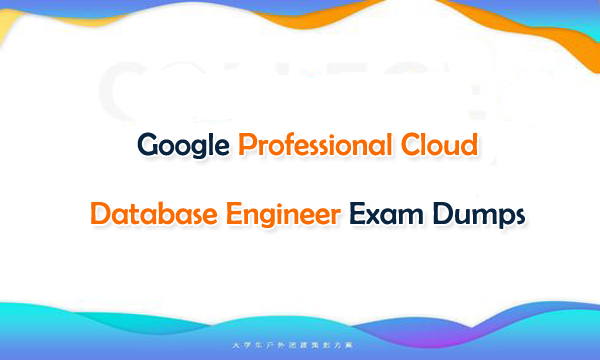Google Professional Cloud Database Engineer Exam Dumps
August 27,2022 03:11 AM
Google Professional Cloud Database Engineer exam dumps have been cracked, which are helpful for you to study the test. A Professional Cloud Database Engineer is a database professional with two years of Google Cloud experience and five years of overall database and IT experience. The Professional Cloud Database Engineer designs, creates, manages, and troubleshoots Google Cloud databases used by applications to store and retrieve data. I also collected other Professional Cloud Database Engineer exam information for you to prepare for this Google test.

Google Professional Cloud Database Engineer Exam
Read Google Professional Cloud Database Engineer exam basic information is a first step for you to study the test well.
Length: 2 hours
Registration fee: $200 (plus tax where applicable)
Language: English
Exam format: Multiple choice and multiple select
Exam Delivery Method:
a. Take the online-proctored exam from a remote location.
b. Take the onsite-proctored exam at a testing center.
Recommended experience: 5+ years of overall database and IT experience, including 2 years of hands-on experience working with Google Cloud database solutions
Professional Cloud Database Engineer Exam Topics
Google Professional Cloud Database Engineer exam topics cover the following details.
Section 1: Design scalable and highly available cloud database solutions
Section 2: Manage a solution that can span multiple database solutions
Section 3: Migrate data solutions
Section 4: Deploy scalable and highly available databases in Google Cloud
Practice Professional Cloud Database Engineer Exam Dumps
The new cracked Google Professional Cloud Database Engineer exam dumps are the best material for you to test the above Google exam topics. Share some Google Professional Cloud Database Engineer exam dumps questions and answers below.
1. You are choosing a new database backend for an existing application. The current database is running PostgreSQL on an on-premises VM and is managed by a database administrator and operations team. The application data is relational and has light traffic. You want to minimize costs and the migration effort for this application. What should you do?
A. Migrate the existing database to Firestore.
B. Migrate the existing database to Cloud SQL for PostgreSQL.
C. Migrate the existing database to Cloud Spanner.
D. Migrate the existing database to PostgreSQL running on Compute Engine.
Answer: B
2. Your organization is currently updating an existing corporate application that is running in another public cloud to access managed database services in Google Cloud. The application will remain in the other public cloud while the database is migrated to Google Cloud. You want to follow Google-recommended practices for authentication. You need to minimize user disruption during the migration. What should you do?
A. Use workload identity federation to impersonate a service account.
B. Ask existing users to set their Google password to match their corporate password.
C. Migrate the application to Google Cloud, and use Identity and Access Management (IAM).
D. Use Google Workspace Password Sync to replicate passwords into Google Cloud.
Answer: C
3. You are configuring the networking of a Cloud SQL instance. The only application that connects to this database resides on a Compute Engine VM in the same project as the Cloud SQL instance. The VM and the Cloud SQL instance both use the same VPC network, and both have an external (public) IP address and an internal (private) IP address. You want to improve network security. What should you do?
A. Disable and remove the internal IP address assignment.
B. Disable both the external IP address and the internal IP address, and instead rely on Private Google Access.
C. Specify an authorized network with the CIDR range of the VM.
D. Disable and remove the external IP address assignment.
Answer: B
4. You are designing a database strategy for a new web application in one region. You need to minimize write latency. What should you do?
A. Use Cloud SQL with cross-region replicas.
B. Use high availability (HA) Cloud SQL with multiple zones.
C. Use zonal Cloud SQL without high availability (HA).
D. Use Cloud Spanner in a regional configuration.
Answer: A
5. You are running a large, highly transactional application on Oracle Real Application Cluster (RAC) that is multi-tenant and uses shared storage. You need a solution that ensures high-performance throughput and a low-latency connection between applications and databases. The solution must also support existing Oracle features and provide ease of migration to Google Cloud. What should you do?
A. Migrate to Compute Engine.
B. Migrate to Bare Metal Solution for Oracle.
C. Migrate to Google Kubernetes Engine (GKE)
D. Migrate to Google Cloud VMware Engine
Answer: A
Professional Cloud Database Engineer Exam Dumps PDF & SOFT | 1 Year Free Update | Money Back Guarantee
- Related Suggestion
- Professional Google Workspace Administrator Certification Exam Dumps August 11,2022
- Google Professional Cloud Security Engineer Exam Updated Dumps May 28,2021
- Google Professional Machine Learning Engineer Dumps Questions March 16,2021
- Google Professional Cloud DevOps Engineer Exam Dumps March 12,2021
- Google Associate Android Developer Exam Dumps February 02,2021

